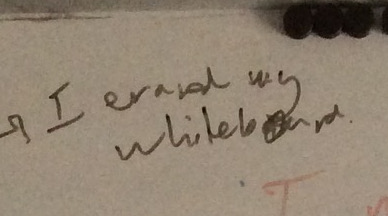Today is the inauguration. It is going to be a day of complicated turbulent energy in the world I inhabit, and probably the one you inhabit as well.
I believe a substantial majority of Americans have misgivings about Donald Trump. Obviously the people who voted against him–a majority of the people who voted, let’s remember–are, to put it mildly, uncomfortable with him. But I strongly suspect a substantial percentage of those who voted for him are troubled by him as well. I believe that most people are decent and try to do good in the world, so I suspect that Trump’s shenanigans–the sexism, the appeals to base racism and xenophobia, the tendency toward pettiness and vindictiveness, the lack of impulse control–have created some apprehensions for most people.
(Now please don’t take that to mean that I think most or even many Trump voters regret their vote. They could have misgivings about Trump and still legitimately prefer him to Hillary Clinton. They may still feel he has the potential to be a good president. I’m merely suggesting that a substantial percentage of Trump voters probably have some ambivalent feelings about the man.)
What’s more, the people who lack those reservations are proving to be the people who feel empowered by the basest elements of Trump’s rhetoric to behave in ways that most of us, irrespective of political affiliation, surely condemn.
And today the man who is the focal point of these emotions and energies will, amid great pomp and circumstance, formally take over the office of the Presidency of the United States, the most powerful office in the world.
So then, what is likely to be the feeling in the collective energy as we ceremonialize this transfer of power? Among those who strongly opposed the man and hate that he got elected, there will be great negativity. Among many of the rest, there will be not celebration but uncertainty. And the ones celebrating are the sort of people who thrive in conditions of dissonance. Add it all up and we can expect today to be a challenging day for most of us.
So how might we approach today so that we survive the day with as little energetic disruption as possible? The strategies I outlined a few weeks ago are as critical today as they’ve ever been. Avoid media of all sorts as much as possible, and avoid social media like the plague, which today from an energetic perspective it is likely to be. If you are inclined to follow Trump’s inaugural address, consider reading a transcript of it after the fact rather than watching it. That way you can best divorce the content from the energetic complexities of Trump himself, as well as the not-exactly-neutral energies of the media. Eat well today, avoiding foods that tend to push us out of balance like refined sugar and alcohol. Spend some time exercising. Spend some time meditating. Should you find yourself feeling agitated during the day, pause, center, close your eyes and take a few centered breaths. And, if at all possible, get out into nature. Trees and rocks and rivers and oceans will never be particularly disturbed by the gyrations and perturbations of humans.
In short, do your best to be a point of equanimity amid the chaos. In turbulent times, which the Trump years almost certainly will be, every person seeking to balance the collective energy rather than distort it is an asset. Be that person.

